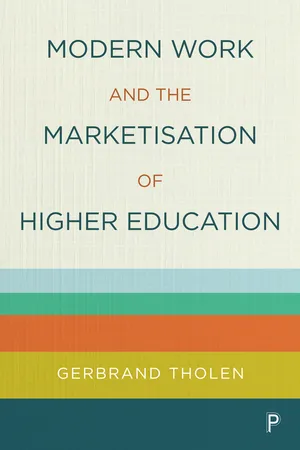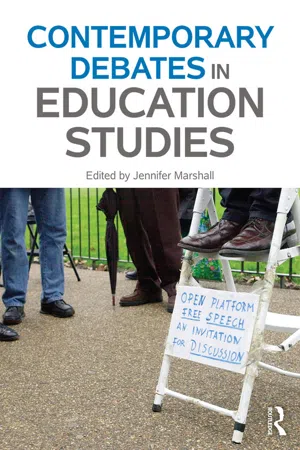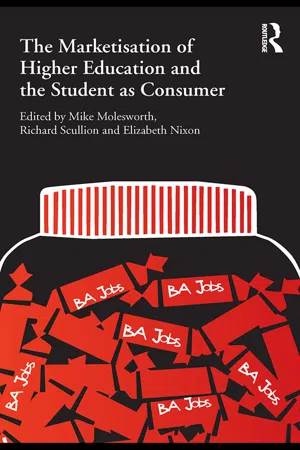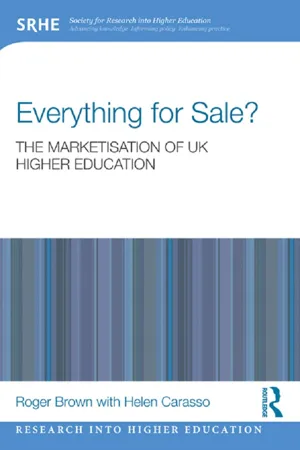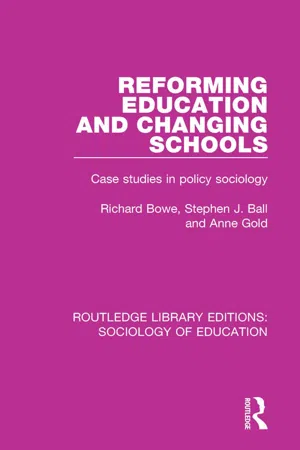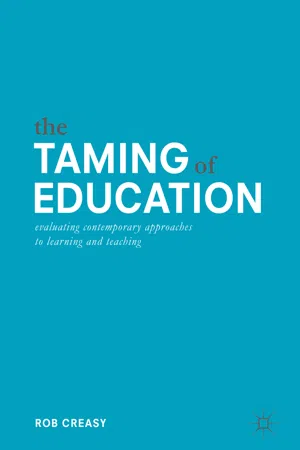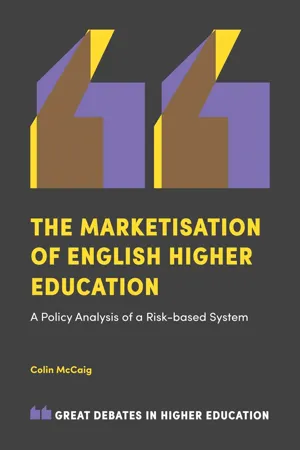Social Sciences
Marketisation of Education
The marketisation of education refers to the trend of applying market principles, such as competition and consumer choice, to the education sector. This approach often involves the introduction of market mechanisms like school choice, performance-based funding, and the promotion of private providers. Proponents argue that it can improve efficiency and quality, while critics raise concerns about inequality and the commodification of education.
Written by Perlego with AI-assistance
Related key terms
Related key terms
1 of 4
Related key terms
1 of 3
10 Key excerpts on "Marketisation of Education"
- Gerbrand Tholen(Author)
- 2022(Publication Date)
- Policy Press(Publisher)
2Dimensions of marketisation
Marketisation has been widely acknowledged as a driving force in modern higher education (HE) systems (Lynch, 2006 ; Molesworth et al, 2011 ; Brown, 2013 ; McGettigan, 2013 ). This chapter explains how the role of competition and markets has transformed HE. It outlines three areas in which marketisation has manifested itself with the current HE landscape in England. These are: the rise of user-pay finance; increasing managerialism; and increasing commodification. Many other influences have been identified as salient impacts of marketisation, including growing within-institution differentiation, changing institutional identity, growing institutional instability, changing societal impact and commercialisation. The consequences covered here are the ones that can be most directly associated with the marketisation policy drive.User-pay
The first key impact and at the same time a cause of marketisation of HE lies in how HE has been financed. Decisions around who should pay for it, in practice, are entwined by debates about whether the market should coordinate education provision. Once the cost of HE has been shifted to its users, rather than from public funds, it positions the institution and student differently in relation to each other. The market–consumer relationship provides a blueprint of how each of them should behave. As explained in the previous chapter , user-pay schemes are thought to lead to a system of financially motivated actors who are incentivised to pay more critical attention to their consumption and supply of HE. As Jongbloed (2003 , p 114) explains: ‘Marketisation policies try to push for self-steering and accountable entities that decide on the basis of reliable information. Through marketisation policies, students and colleges are encouraged to make their own cost-benefit analyses.’In the English context, the perhaps most apparent change in HE provision is the rise in (undergraduate) tuition fees. Although state support for either student or institution has not always been a significant feature of the HE system, from the early 20th century this gradually changed as the state started funding its institutions. By the middle of the century, the state provided 90 per cent of university income (Newton et al, 2017 , p 5). By 1962, there was free tuition for full-time domestic students, combined with maintenance grants and loans for students. The year 1998 saw the introduction of tuition fees paid by undergraduate students in England. The fees of up to £1,000 per year were to be paid up-front, but means-tested such that low-income students would still face no tuition fees. In 2006, tuition fees rose to £3,000 per year, and were no longer charged up-front but via an expansion of the income-contingent loan. Higher fees pleased Conservatives concerned at the rising contribution by the taxpayer. Labour also saw the increase in fees as a means to increase participation, aiding social mobility. Students from middle- and upper-class families were the beneficiaries of university, enjoying private returns from their publicly funded degrees. Charging tuition fees would bring in funds from those groups while offering opportunities to support low-income students (Murphy et al, 2019 ). In September 2012, HE institutions in England were permitted to triple their annual tuition fee from £3,000 to £9,000. The loans were still income-contingent, with a threshold for repayment of £21,000 per year with positive real interest rates applied. Teaching grants were cut radically, with lecture-based subjects receiving no government subsidies for teaching students. The intended competition on price between institutions never materialised as practically all institutions have opted to charge the maximum for the full-time undergraduate courses. The political aim of establishing an undergraduate market through the promotion of differentiation in tuition fees has not been lost, however (DBIS, 2015 , 2016 ). Fee variation remains to be seen by many as the necessary mechanism for student consumers to be able to drive improvements in quality, affordability and differentiation effectively. Whether the fee increase has decreased the pressure on the public finances remains to be seen. Tuition fees are not paid up-front. Instead, students cover the cost of their degree through loans and only repay when they earn above an earnings threshold (currently £27,295 a year). How much the increase has lowered the burden on the taxpayer remains somewhat unclear. Furthermore, the sell-off of the loan book allows private capital to flow into HE finance and so this reliance on financial markets could increase the stability of the finance model (Hale, 2018- eBook - ePub
- Jennifer Marshall, Jennifer Marshall(Authors)
- 2017(Publication Date)
- Routledge(Publisher)
Equally important, however, is the risk that, unless it is carefully controlled, competition leads to rationalization and an actual reduction in diversity and consumer choice. The publication of test results has produced a ‘quasi-market’ of winners and losers within the school system. The concepts of economics as a motivator to marketization of education are highly criticized by Lauder (2006), who argued that economic factors have replaced the learning aspects of education to more material-oriented learning processes, whereby schools concentrate on how they can achieve customer satisfaction as opposed to impartation of knowledge and skills. As long ago as the 1990s, Lauder was arguing that marketization of education arose due to the emergence of the class system. Parents from rich backgrounds saw the need for taking their children to private schools, because they offered higher quality education over state schools (Lauder et al., 1999). This aspect caused a rift between the rich and the poor in the educative process in terms of acquisition of knowledge. Bates et al. (2011) and Kishan (2008) observe that parents with low incomes struggle to send their children to private schools, and this accelerates the process of social segregation. The European Research Institute of Education conducted research on the marketization of education in Europe. It found that the state had lost its ability to regulate the education system in Europe as a result (Kishan, 2008). Another aspect of the marketization of education is the changing needs of the society that the education system needed to address. This issue is vague in its description, because education is age-old, and issues affecting the society are the same. Lauder (2006) agrees with this notion and notes that the education system concerns itself with the impartation of skills necessary for an individual to survive in the world - Mike Molesworth, Richard Scullion, Elizabeth Nixon, Mike Molesworth, Richard Scullion, Elizabeth Nixon(Authors)
- 2010(Publication Date)
- Routledge(Publisher)
In the other camp, there are those who consider that the shift towards the marketised university is having a deleterious impact on the university (for example, Reid 1996). There are nuances in this position, too. There are those who are prompted by a concern with the student experience and the claimed effect on the pedagogical relationship wrought by the student market, as students become ‘customers’. There are also those who are concerned about the university as a social institution and who believe that marketisation is corrupting the university as an embodiment of public goods.Noticeable in this polarisation of views – between the pro-marketers and the anti-marketers – are two similarities. Both would claim to ground their positions on empirical evidence but also both are imbued with a value position focused on the market as such. That is to say, the empirical evidence that each side would point to serves as a rationalisation of a prior position taken up either in favour of or against the market. The issue of the market in higher education, therefore, is an ideological site (cf. Barnett 2003). The positive and the hostile positions are taken up first and the evidence is found to support the position taken. It appears as if there is a debate, since evidence is brought to bear by the opposing parties but for the most part it amounts to a trading of fixed value-laden positions.Is there, then, a way through that will allow a less value-driven view to be developed? Is the market – which for many is indefensible – defensible? Is there something intrinsically or logically problematic with the marketisation of higher education? Alternatively, are there features of markets that might turn out to be beneficial for the development of higher education and the university? Might there just be available a position that offers a reconciliation of the polarised positions?Context: market plurality and market fuzziness
Worldwide, universities experience the presence of the market to some extent. ‘Partial marketisation is a feature of many if not most national systems’ (Marginson 2007: 42; also see Brown in this book). In most higher education systems, universities have some freedom to generate income for themselves and are not totally dependent on state finance. To a greater or lesser extent, universities tend to be operating in the public sector and- eBook - ePub
Student Identity and Political Agency
Activism, Representation and Consumer Rights
- Rille Raaper(Author)
- 2023(Publication Date)
- Routledge(Publisher)
1 HIGHER EDUCATION FOR SALE Exploring marketisation and massificationDOI: 10.4324/9781003253648-2Introduction
Over the past few decades, the purposes of higher education and our role within it as students and academics have changed substantially. It is not an exaggeration to claim that university education has turned into a commodity that can be sold and purchased on a global scale. Students are often portrayed as consumers of this commodity and academics as service providers. Such changes cannot be understood without comprehending the wider societal changes shaped by neoliberalisation processes. This chapter situates the changes shaping universities in the context of neoliberalism, which reflects on marketisation and massification of the sector, but more importantly, on a situation where neoliberalism has turned into a dominant mode of governance that dictates our understandings of education, universities and ourselves. I will conclude the chapter by discussing the twisted form of neoliberalism that we witness today: The neoliberal ideology that perpetuates inequalities and individualism under the illusion of meritocracy. I argue that such dominant ideology dismantles higher education; it also shapes our relationships to each other, and what it means to be a student today.Some would argue that neoliberalism means everything and nothing today, and it has become an outdated concept. Rodgers (2018 , p. 80) describes neoliberalism as ‘the linguistic fad and hegemon of our times’, and Rowe et al. (2019 , p. 151) are concerned that neoliberalism is often taken up with ‘very little critique or precision’. Since the beginning of the COVID-19 pandemic, there has also been a hope that the global crisis and the urgent need for state intervention over free-market policies would see the end of neoliberalism. This has been reflected in various news and social media posts, including titles such as ‘Neoliberalism under threat: coronavirus and the return of the social’ (Vallelly, 2020 ), ‘Neoliberalism is dying – now we must replace it’ (Meadway, 2021 ), and ‘The neoliberal era is ending. What comes next?’ (Bregman, 2020 - Roger Brown, Helen Carasso(Authors)
- 2013(Publication Date)
- Routledge(Publisher)
Chapter 7
The impact of marketisation
Efficiency, diversity and equity
This analysis points to the importance of autonomy, competition and suitable funding if there is to be responsiveness and high quality in universities. In contrast to the position in much of continental Europe … universities in the UK have had a long tradition of both autonomy and competition. The UK reforms have enhanced competition. The introduction of tuition fees … has led to more adequate funding and more direct influence by universities over the level of that funding.(Clark, 2009, p. 15)This chapter summarises what we know from the existing literature about the impact of the marketisation of higher education across the globe and considers how far what has happened in the UK since 1979 is consistent with this picture, referring to efficiency, institutional diversity and widening participation. Chapter 8 looks at the effects on quality and on the universities’ ability to control the ‘academic agenda’. An overall assessment of the impact of marketisation in the UK to date is at the end of that chapter.Marketisation for and against
The literature on the marketisation of higher education is extensive and becoming even more so almost by the minute (e.g., Thornton, 2012). What follows in this section is taken principally from the author's recent (2011a and b) international surveys, updated as necessary.Williams's (1995, p. 179) formulation of the assumptions on which the marketisation of higher education is based remains as valid as any:- eBook - ePub
Reforming Education and Changing Schools
Case studies in policy sociology
- Richard Bowe, Stephen J. Ball, Anne Gold(Authors)
- 2017(Publication Date)
- Routledge(Publisher)
Chapter 2 Education in the marketplace As of 1 April 1990 many state-funded schools in England and Wales formally took control of their own budgets under the LMS (Local Management of Schools) provisions of the Education Reform Act 1988. At the same time Open Enrolment was introduced and the phasing in of per capita related funding of schools was begun. In effect a quasi-market in education was established. The issue of the influence of markets on public sector welfare provision and in education in particular is one of the most important research topics of the 1990s. The Government’s legislation programme has created a ‘natural experiment’ that presents researchers with an extraordinary opportunity to study the constitution and effect of market forces upon public service organizations. We suggest that the LMS/market package for schools rests upon two closely interrelated bases, (1) The neo-liberal economic theories of the market, particularly the work of Friedrich Hayek and his fellow Austrians; (2) recent developments in management theory and business methods which rest on a belief in achieving greater effectiveness through financial delegation; which, it is argued, provides for greater responsiveness to clients. The Peters and Waterman (1982) book In Search of Excellence is a key text here. The delegation argument contends that those actively engaged in delivering the service to the client are best placed to decide how to use resources most effectively and efficiently. It is important to underline the interrelation between these two bases. Government strategies for changing schools clearly link the use of market forces with the reform of school management. The former changes the basis of the consumers’ relation to the school. The latter changes the means and medium of the producers’ response - Hong Zhen Zhu, Shiyan Lou(Authors)
- 2011(Publication Date)
- Chandos Publishing(Publisher)
3 It can be seen that both the objective situation facing higher education in China and the attributes and functions of higher education itself require a new market-oriented mechanism or system to innovate the original one. Only by relating closely to the demand of the market can a country’s higher education develop healthily and at the same time make the maximum contribution to the country and society, which is demonstrated by the reality and practice of developed countries. Marketization is the only approach to enable the state-owned higher education to compete in the market, improve quality and efficiency and optimize the structure in order to reap more economic and social benefits. Only by forcing higher education to compete in the market can a fundamental change of the Chinese current education system take place. By marketization, the current monopoly of public university on education could be broken and competition could be brought about to public higher education so that public universities are forced to carry out reform on the present administration system and exert themselves to meet the needs of the social and economic demand and the development of the market economy.Approaches to marketization of higher education
Marketization of higher education aims at getting rid of the traditional administration model of government monopoly to increase the autonomy of HEIs and to introduce market mechanisms to improve the efficiency and to give full play to the role of higher education in the development of society. Market mechanism mainly refers to the price system and competition; autonomy of HEIs is mainly concerned with the internal and external affairs such as teaching, research, personnel, finance, infrastructure, recruitment, foreign exchange and so on. According to education theorist Jog Koelman, marketization of higher education should have the following three characteristics: first, autonomy of HEIs: the government should entitle the HEIs full authority so that the HEIs will respond rapidly to market signals according to their own characteristics and advantages; second, to replace the funding system which relies solely on the government by a new one with funding shared between the government and social forces; third, the quasi-market essence of the higher education market.4- eBook - ePub
The Taming of Education
Evaluating Contemporary Approaches to Learning and Teaching
- Rob Creasy(Author)
- 2017(Publication Date)
- Palgrave Macmillan(Publisher)
employability’ skills in graduates such as business-awareness and self-management” (p. 42). Throughout the document there is a focus upon how Higher Education can supply employers with skills and how students will become more employable. This is contextualised within the idea that the UK operates within a globally competitive market. If Higher Education is to supply graduates with particular skills, it can be seen that these are skills which the State, along with business, and the market, values. These will not necessarily be those which academics value. As such there is pressure on teaching staff to assess for things with which they have not traditionally been concerned with.The developing discourse of markets in relation to Higher Education which is evident within “Higher Ambitions” is clearly important in understanding policy developments. It can be seen in the partial adoption by the government of the Browne report (2010 ), together with significant funding cuts as detailed in the comprehensive spending review of October 2010. This change reinforces the concept of the student as consumer by changing the funding of Higher Education programmes so that students pay significantly more than previously. This does not imply that the full costs of Higher Education have been shifted to the student but significant costs have been imposed upon them.The intention was that Higher Education Institutions would charge varying fees and so students would choose a programme in a manner that was analogous to making any other purchase. This reflects the general approach that has been taken by governments in the UK which have aimed to create, or replicate, markets within sectors where a market was seen to be absent (Brown and Carasson 2013 ). This approach sees governments acting to impose the logic of the market to areas which appear to exist outside of the market economy by virtue of being part of the public sector. Although government action in this way seems to run counter to the critical approach adopted by neoliberals towards State intervention, it does not undermine the neoliberal argument. Neoliberalism readily accommodates State intervention as being necessary where goods and services are provided for outside of a market environment if the aim of that intervention is to facilitate the move towards a free market (Olssen 2016 ; Hayek 2013 ; Turner 2011 ). This is not the same, however, as arguing that a free market exists as a consequence of such actions. However, although there may be doubts as to the extent that a market has been created, Hughes (2007 , 12) demonstrates the extent to which the discourse of markets has become embedded within the sector when she writes:Today’s UK university students buy a degree. Some also buy a university education. We live in a consumer economy. Education purchases are no different. Those coming into higher education, and those who support them, are buying something. They are arguably little different from consumers walking into shops. - eBook - ePub
Markets for Schooling
An Economic Analysis
- Nick Adnett, Peter Davies(Authors)
- 2002(Publication Date)
- Routledge(Publisher)
2 Education and the economyExamining the context of schooling markets 2.1 IntroductionThe dissatisfaction felt by many Western governments with the performance of their public schooling system towards the end of the last century partly reflected a concern that existing and future economic and social challenges were not being adequately responded to by that system. From the 1970s it was believed in much of Europe and North America that slowdowns in economic growth and losses in international competitiveness were partly the result of failures in the schooling system (Adnett 1997). Similarly, the growth in labour market inequality, predominantly wage inequality in the US and employment inequality in Europe, was partly attributed to a schooling system that was failing those towards the bottom end of the ability range. In this chapter we explore the broader economic and social context of schooling systems in developed countries. The underlying motivation for this review rests upon two issues. First, to investigate the extent to which changes in the economic and social environment were responsible for the introduction of market-based reforms of state schooling. Second, to identify those environmental factors that may influence the outcome of those reforms.The dissatisfaction with the performance of state schooling also reflected policy makers’ loss in confidence in two key propositions, commonly used as a basis for educational and social policy in the second half of the last century. First, that the extension of general subsidies for investments in human capital could effectively tackle poverty and labour market discrimination. Second, that sustained economic growth would automatically generate sufficient ‘trickle-down’ effects to promote social inclusion and prevent widening income inequality. The collapse of the conventional wisdom based upon these two propositions has led a fundamental rethinking of social, educational and training policy amongst both neo-liberal and third-way analysts. In Europe, shared concerns about the consequences of increased globalisation and the emergence of the ‘new economy’ have led to major changes in these policies. At the Lisbon and Nice Councils of Ministers in 2000 there was agreement of the need for fundamental education and training reforms which would promote European leadership of the ‘knowledge-based’ global economy (Adnett 2001). - eBook - ePub
The Marketisation of English Higher Education
A Policy Analysis of a Risk-Based System
- Colin McCaig(Author)
- 2018(Publication Date)
- Emerald Publishing Limited(Publisher)
INTRODUCTION: THE MARKETISATION OF ENGLISH HIGHER EDUCATION
This book traces the long development of a recognisably marketised higher education (HE) system in England over a 30-year period from the mid-1980s and identifies five distinct stages of market reforms culminating in the Higher Education and Research Act (HERA) (HMSO, 2017) which introduced the risk of institutional exit (DBIS, 2015, 2016) to the already competitive market system established by earlier policy change (DBIS, 2011; DfES, 2003; HM Government, 2004). The HERA effectively shifts the risks of institutional failure onto students by presenting them with ever more applicant choice information and encouraging them to use their consumer behaviour to oblige weaker providers either to lower tuition fees or to lose market share to (newly encouraged) competitors. The new Office for Students (OfS) would regulate the system through the application of risk, concentrating its oversight mainly on those institutions that perform poorly against a range of monitoring data, including those relating to teaching quality. The OfS would no longer prop up (through student number allocations or cash) those institutions that failed in this newly competitive environment, and it would overtly encourage new providers to replace them – by taking their market share – or to create additional supply. Either or both of these mechanisms are assumed by policymakers to create a further fee differential by reducing the average tuition fee charged by providers that are not deemed to be the best. This represents a marked departure from previous attempts to introduce market dynamism into the sector and places the English HE system at the forefront of marketisation. This book, which traces the development of policy over a 30-year period, can therefore act as a ‘how-to’ guide or a warning of things to come in comparative analysis.
Index pages curate the most relevant extracts from our library of academic textbooks. They’ve been created using an in-house natural language model (NLM), each adding context and meaning to key research topics.
Explore more topic indexes
Explore more topic indexes
1 of 6
Explore more topic indexes
1 of 4
